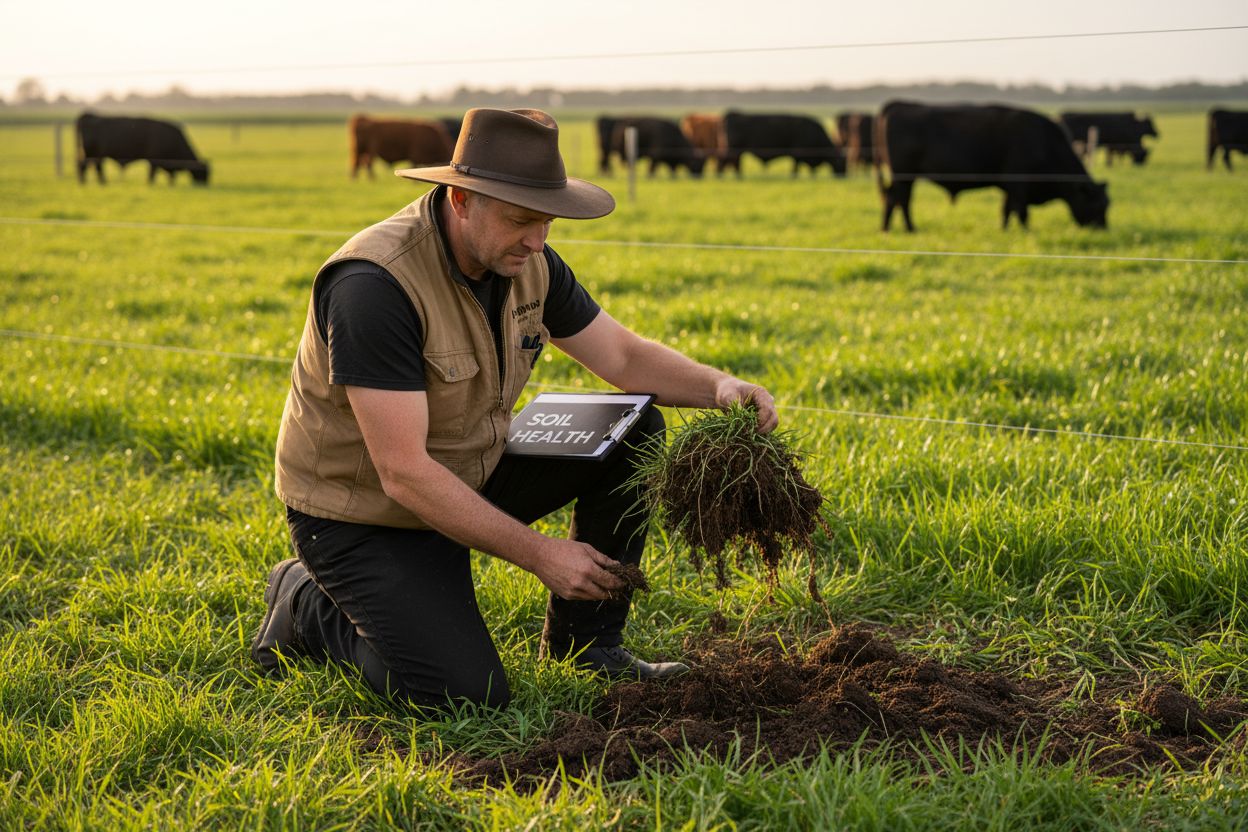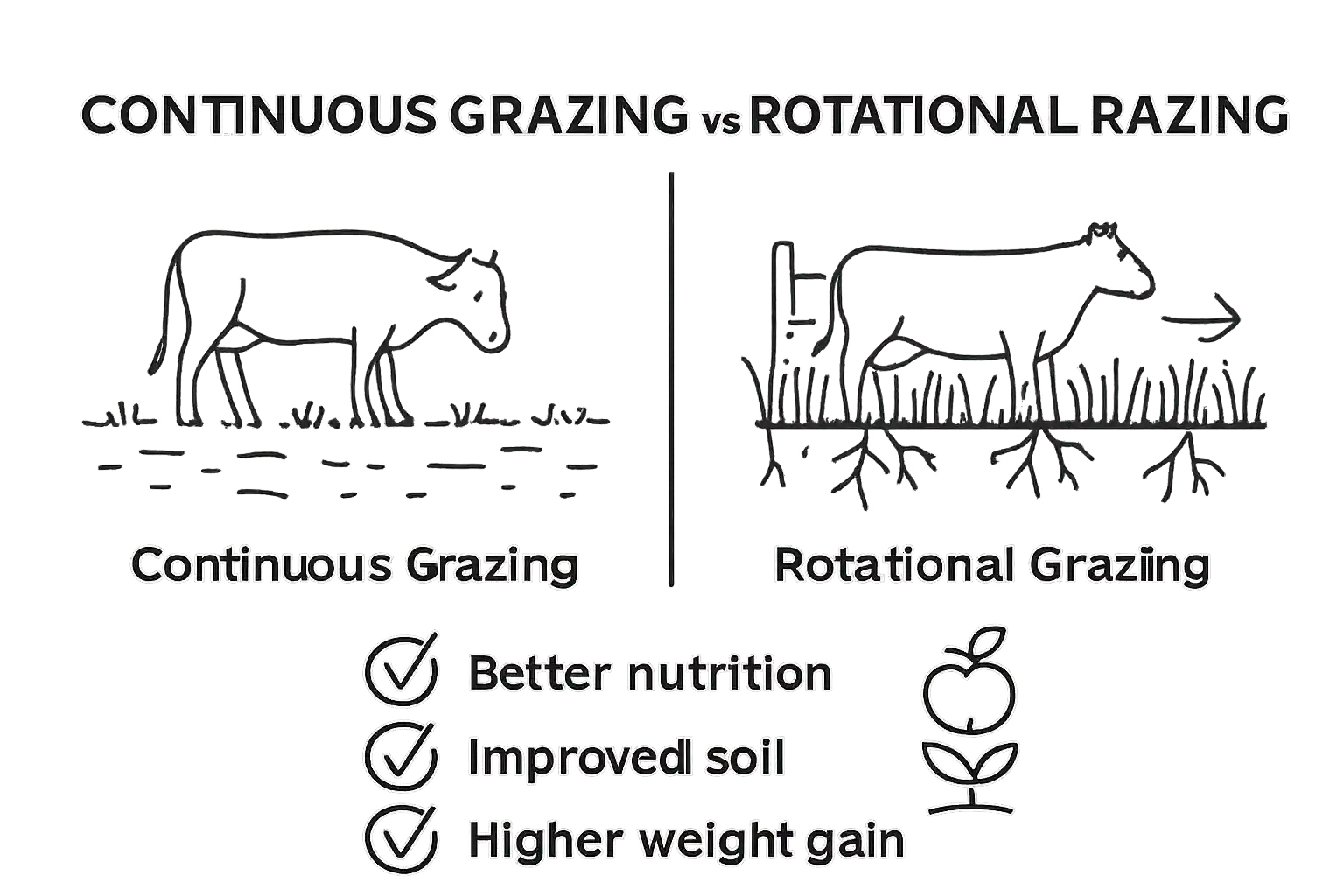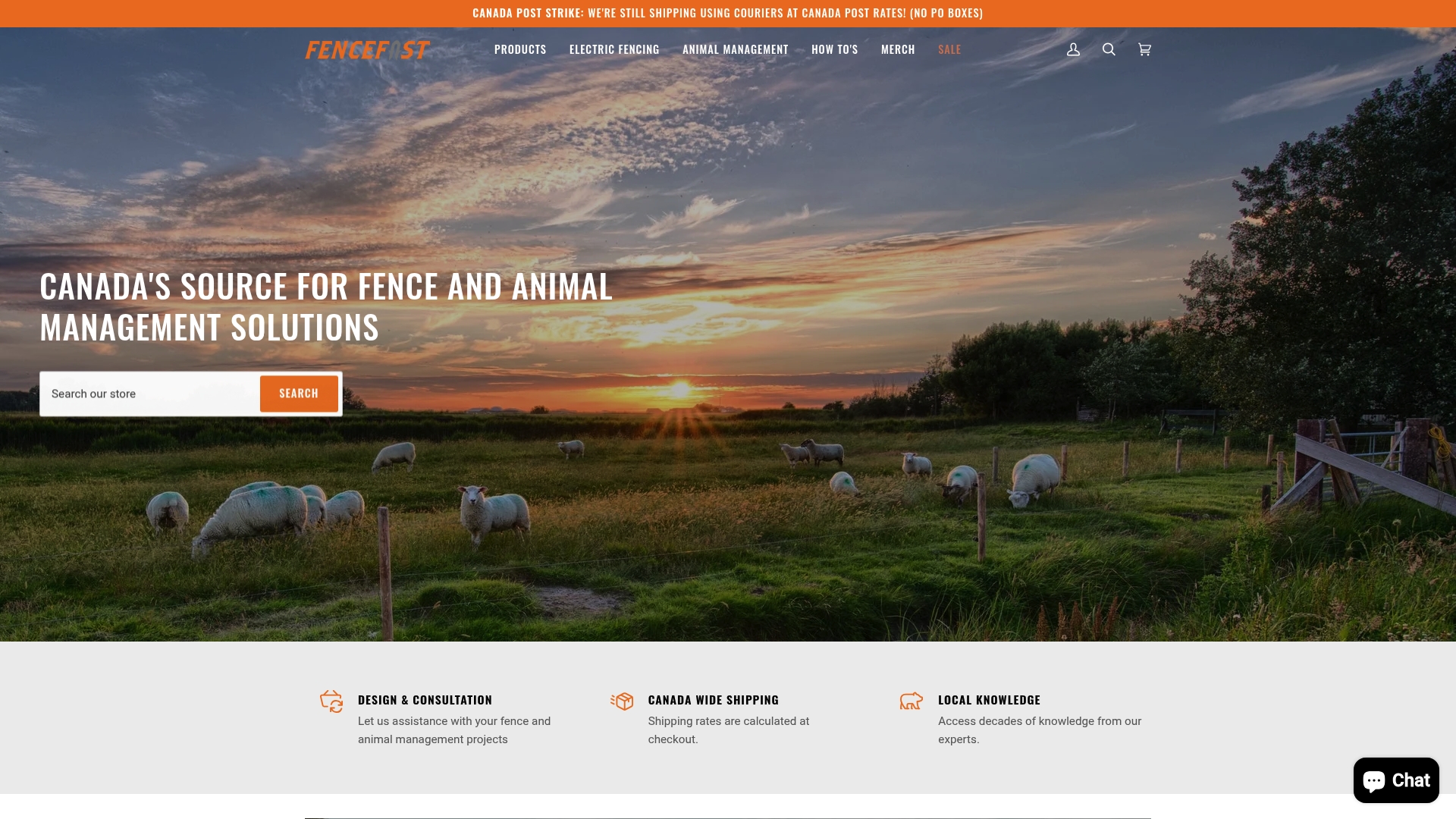Farmers are rethinking how they let livestock graze and many are switching to rotational grazing because it can create healthier pastures and animals. Continuous grazing used to be the norm, but studies now show that strategic rotation can boost livestock weight gain by up to 30 percent over traditional methods.
Below is a comparison of continuous grazing and rotational grazing, highlighting their respective impacts and characteristics based on details discussed in the article.
| Practice | Description | Impacts on Pasture | Impacts on Livestock |
|---|---|---|---|
| Continuous Grazing | Livestock graze freely in one area season-long | Often leads to overgrazing | Lower weight gain, higher stress |
| Rotational Grazing | Systematic movement between divided paddocks | Healthier, recovering grass | Up to 30% more weight gain, improved health |
| The real surprise is that this same system can turn overused land into thriving ecosystems—and even help fight climate change at the same time. |
Table of Contents
- What Is Rotational Grazing And Its Principles?
- Why Rotational Grazing Matters For Soil Health
- The Impact Of Rotational Grazing On Livestock Productivity
- How Rotational Grazing Supports Biodiversity
- Key Concepts And Best Practices In Rotational Grazing
Quick Summary
| Takeaway | Explanation |
|---|---|
| Strategically rotate livestock for pasture performance | Moving herds between paddocks maximizes grass recovery and nutrient distribution, enhancing overall pasture health. |
| Promote soil health through controlled grazing | Rotational grazing supports microbial diversity and nutrient cycling, leading to improved soil quality and carbon sequestration. |
| Enhance livestock nutrition and health | Animals benefit from diverse forage and reduced stress, resulting in better weight gain and lower parasite exposure. |
| Foster biodiversity in agricultural landscapes | This practice creates varied habitat structures, supporting native plant and wildlife populations while preventing monoculture. |
| Implement adaptive management strategies in grazing | Regularly monitor pasture conditions and livestock performance to make informed adjustments to grazing plans. |
What is Rotational Grazing and Its Principles?
Rotational grazing represents a strategic livestock management approach that maximizes pasture productivity and animal health by systematically moving herds between different grazing areas. Unlike traditional continuous grazing methods, this technique involves dividing agricultural land into multiple paddocks and carefully managing livestock movement to optimize pasture regeneration and nutrient distribution.
The Core Philosophy of Rotational Management
At its foundation, rotational grazing operates on a fundamental principle of ecological balance. By preventing animals from continuously grazing the same area, farmers create an environment where grass can recover, root systems can strengthen, and soil health can be maintained. Agricultural Research Service studies demonstrate that this method significantly improves grassland sustainability compared to conventional grazing techniques.
Key principles of rotational grazing include:
- Strategic movement of livestock between pasture sections
- Allowing sufficient recovery time for grass between grazing periods
- Maintaining optimal plant height and root system health
- Preventing overgrazing and soil compaction
Biomimicry in Pasture Management
Rotational grazing essentially mimics natural grazing patterns observed in wild herding animals like bison and wildebeest. In natural ecosystems, these animals move continuously, preventing prolonged grazing in a single location. National Sustainable Agriculture Information Service notes that this movement pattern allows vegetation to regenerate and prevents ecosystem degradation.
By implementing a similar approach on managed farmland, ranchers can replicate these natural processes. This method promotes more uniform grass utilization, reduces selective grazing, and encourages more even nutrient distribution across pasture lands. The strategic movement prevents animals from consuming only the most palatable grasses, which would typically occur in continuous grazing systems.
Successful rotational grazing requires careful planning, understanding of local ecosystem dynamics, and a commitment to monitoring pasture conditions. Farmers must assess factors like grass species, livestock type, seasonal variations, and soil characteristics to design an effective rotational strategy that supports both animal nutrition and landscape health.
Why Rotational Grazing Matters for Soil Health
Soil health represents a critical foundation for sustainable agricultural practices, and rotational grazing emerges as a powerful method to enhance and preserve soil ecosystem integrity. By strategically managing livestock movement, farmers can transform soil conditions from degraded landscapes to thriving, nutrient-rich environments.
Soil Microbiome and Nutrient Cycling
Rotational grazing plays a pivotal role in supporting complex soil microbiological processes. USDA Soil Health Institute research demonstrates that controlled livestock movement stimulates microbial diversity and accelerates nutrient cycling. When animals graze and then move, they create conditions that encourage beneficial bacterial and fungal growth, which are essential for breaking down organic matter and making nutrients available to plant roots.
Key benefits for soil microbiome include:
- Enhanced microbial population diversity
- Improved organic matter decomposition
- Increased nutrient availability for plant growth
- Reduced soil compaction compared to continuous grazing
Impact on Soil Structure and Carbon Sequestration
Beyond microbial dynamics, rotational grazing significantly influences soil physical structure and carbon storage. Soil Science Society of America studies indicate that strategic grazing promotes deeper root development and increases soil organic carbon content. The periodic movement of livestock prevents continuous trampling, allowing grass root systems to develop more extensively and create stronger soil aggregates.
Carbon sequestration becomes a natural byproduct of this approach, with healthy grasslands capturing atmospheric carbon and storing it within soil structures. This process not only improves soil quality but also contributes to mitigating climate change impacts.
 Our guide on sustainable agricultural practices provides additional insights into landscape management techniques.
Our guide on sustainable agricultural practices provides additional insights into landscape management techniques.
The intricate relationship between livestock, vegetation, and soil represents a delicate ecological balance. Successful rotational grazing requires understanding local ecosystem characteristics, monitoring soil conditions, and adapting management strategies to support long-term soil health and agricultural productivity.
The Impact of Rotational Grazing on Livestock Productivity
Rotational grazing transforms traditional livestock management by directly enhancing animal health, nutrition, and overall farm productivity.
This strategic approach goes beyond simple pasture management, creating a dynamic environment that supports optimal animal development and performance.
Nutrition and Grazing Behavior
Livestock experience significant nutritional benefits through rotational grazing systems. Animal Nutrition Research Institute research indicates that strategic paddock rotation provides animals access to higher quality, more diverse vegetation. When herds move between pastures, they encounter younger, more nutrient-dense grass shoots that contain higher protein levels and improved digestibility.
Key nutritional advantages include:
- More consistent nutrient intake
- Reduced selective grazing
- Enhanced dietary diversity
- Improved forage quality
Health and Performance Metrics
Rotational grazing directly correlates with improved livestock health and performance. Animals in well-managed rotational systems demonstrate lower stress levels, reduced parasite exposure, and more consistent weight gain. National Livestock Association studies show that carefully planned grazing rotations can increase weight gain by up to 30% compared to continuous grazing methods.
The movement between pastures interrupts parasite life cycles, naturally reducing the need for chemical interventions. This approach supports both animal wellness and our sustainable farming practices guide by minimizing external medical treatments.

Successful rotational grazing requires careful observation, understanding animal behavior, and adapting management strategies to local environmental conditions.
This table summarizes the key benefits of rotational grazing for livestock, soil, and biodiversity, as outlined throughout the article.
| Benefit | How It Works | Resulting Impact |
|---|---|---|
| Improved Forage Quality | Livestock access young, nutrient-dense grasses | Better nutrition, enhanced weight gain |
| Soil Health Enhancement | Movement stimulates microbes, reduces compaction | Increased fertility, carbon sequestration |
| Biodiversity Support | Varied grazing creates habitat and preserves plant species | More wildlife, resilient plant communities |
| Natural Parasite Control | Shifting pastures disrupts parasite life cycles | Lower need for chemical treatments |
| Reduced Overgrazing | Rest periods for paddocks allow grass recovery | Healthier pastures, sustained productivity |
| Farmers who invest time in designing effective rotation systems can expect substantial improvements in livestock productivity, animal health, and overall farm sustainability. |
How Rotational Grazing Supports Biodiversity
Rotational grazing emerges as a sophisticated ecosystem management strategy that extends far beyond livestock production, playing a crucial role in maintaining and enhancing biodiversity across agricultural landscapes. By mimicking natural grazing patterns, this approach creates dynamic environments that support complex ecological interactions.
Plant Diversity and Habitat Complexity
Strategic rotational grazing generates a mosaic of vegetation structures that accommodate diverse plant and animal species. US Forest Service Research indicates that controlled livestock movement prevents uniform landscape transformation, enabling multiple plant communities to coexist and thrive. This heterogeneous landscape provides critical microhabitats for numerous organisms.
Key biodiversity benefits include:
- Preservation of native grass species
- Creation of varied vegetation height and density
- Increased ground cover for small wildlife
- Reduced risk of plant monoculture
Wildlife Ecosystem Interactions
Rotational grazing fundamentally transforms agricultural landscapes into dynamic ecological systems. Controlled grazing creates intricate habitat mosaics that support ground-nesting birds, pollinators, and small mammal populations. By preventing continuous, uniform vegetation management, farmers inadvertently generate complex ecological niches that support wildlife diversity.
Wildlife Conservation Society research demonstrates that well-managed rotational grazing can increase ground-dwelling species populations by providing intermittent disturbance patterns that mimic natural ecosystem dynamics. These management techniques create temporary open areas, seed dispersal opportunities, and varied terrain that support multiple species simultaneously.
Successful biodiversity enhancement through rotational grazing requires nuanced understanding of local ecosystem characteristics, careful monitoring, and adaptive management strategies. Farmers become ecosystem stewards, balancing livestock productivity with environmental conservation goals.
Key Concepts and Best Practices in Rotational Grazing
Rotational grazing represents a sophisticated agricultural management strategy that requires careful planning, systematic implementation, and ongoing monitoring to achieve optimal results. Successful execution demands a comprehensive understanding of ecological principles, livestock behavior, and pasture dynamics.
Paddock Design and Livestock Allocation
Sustainable Agriculture Research Foundation research emphasizes the critical importance of strategic paddock design in rotational grazing systems. Effective management involves dividing pastureland into multiple sections that allow for systematic livestock movement and adequate vegetation recovery periods.
Key considerations for paddock design include:
- Matching paddock size to herd numbers
- Ensuring water accessibility in each section
- Creating flexible boundary configurations
- Accounting for terrain and vegetation variations
Monitoring and Adaptive Management
Successful rotational grazing is not a static process but a dynamic, responsive approach to land management. Farmers must continuously assess pasture conditions, livestock health, and ecological indicators to make informed adjustments. Our sustainable farming practices guide provides additional insights into adaptive agricultural strategies.
Critical monitoring parameters include:
- Grass height and recovery rates
- Soil moisture and compaction levels
- Livestock weight gain and health indicators
- Biodiversity and ecosystem changes
Effective rotational grazing transcends simple livestock management, emerging as a holistic approach to agricultural ecosystem stewardship. Farmers who invest time in understanding complex interactions between animals, vegetation, and landscape can transform traditional grazing methods into regenerative agricultural practices that support long-term environmental and economic sustainability.
Ready to Transform Your Pastures with Effective Rotational Grazing?
Managing livestock through rotational grazing brings big rewards. However, it is not always easy to keep pastures healthy, minimize overgrazing, and ensure your animals have what they need. Many farmers face the challenge of poor pasture recovery, uneven grazing patterns, and wasted resources when trying to implement these principles. If you are looking for reliable ways to improve paddock design, support soil health, and boost livestock productivity as highlighted in this article, you need tools and supplies you can count on.

Visit FenceFast.ca to explore fencing systems, electric fence solutions, animal monitoring tools, and much more. Make your rotational grazing strategy efficient and stress-free today. Shop now for proven products that help you achieve regenerative results right at your farm. It is time to modernize your approach to animal and land management. Discover essential livestock management supplies to support your journey and get nationwide shipping on your order.
Frequently Asked Questions
What is rotational grazing and how does it work?
Rotational grazing is a livestock management technique that involves systematically moving herds between different grazing areas (paddocks) to maximize pasture productivity and animal health. This method allows for pasture regeneration and nutrient distribution by preventing overgrazing in any single area.
How does rotational grazing improve soil health?
Rotational grazing enhances soil health by promoting microbial diversity, improving organic matter decomposition, and increasing nutrient availability for plant growth. The movement of livestock stimulates beneficial microbial activity, resulting in healthier soil structure and carbon sequestration.
What are the benefits of rotational grazing for livestock nutrition?
Livestock experience improved nutrition through rotational grazing as they access younger and more nutrient-dense grasses. This results in a more consistent nutrient intake, reduced selective grazing, and better overall forage quality, which can enhance animal health and growth rates.
How can I implement rotational grazing on my farm?
To implement rotational grazing, start by designing paddocks based on herd size, water accessibility, and terrain variation. Monitor pasture conditions, livestock health, and ecological indicators regularly to adjust the grazing plan and ensure optimal recovery times for the grass.
